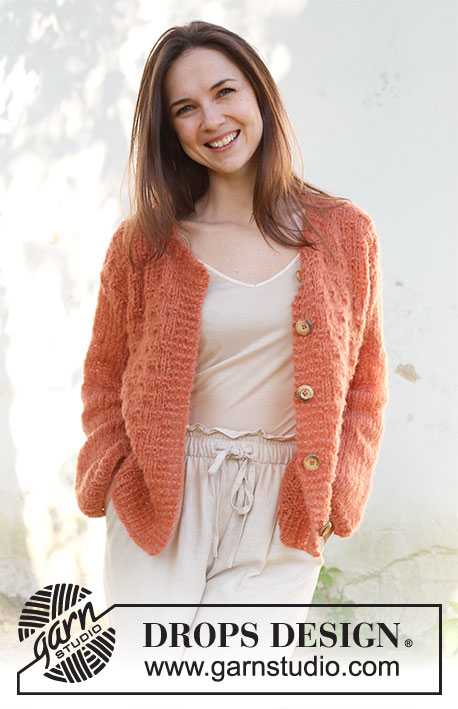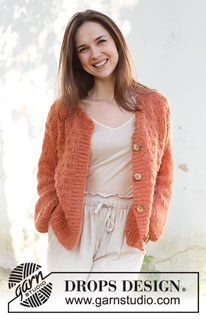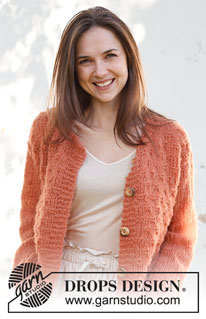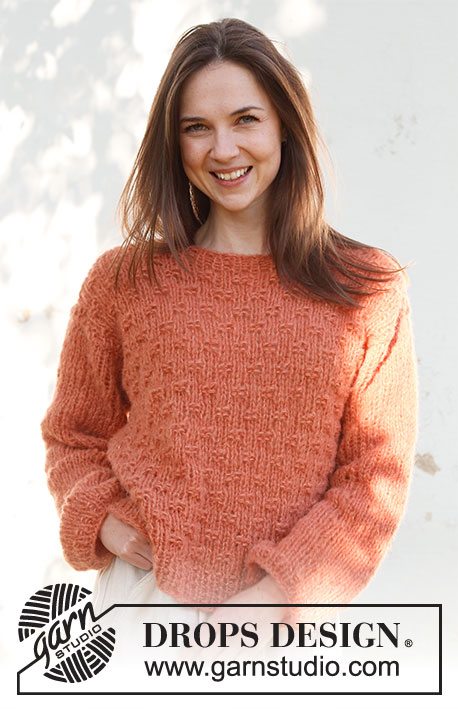Maggie's Bricks Cardigan |
||||||||||
 |
 |
|||||||||
Knitted jacket in 2 strands DROPS Brushed Alpaca Silk or 1 strand DROPS Wish. The piece is worked bottom up, with pattern and split in the sides. Sizes S - XXXL.
DROPS 231-29 |
||||||||||
|
------------------------------------------------------- EXPLANATIONS FOR THE PATTERN: ------------------------------------------------------- RIDGE/GARTER STITCH (worked back and forth): Knit all rows. 1 ridge = knit 2 rows. PATTERN: See diagram A.1. The diagram shows all the rows in the pattern from the right side. BUTTONHOLES (bottom up): Work the buttonholes on the right band. 1 BUTTONHOLE = knit together the 3rd and 4th stitch from the edge and make 1 yarn over. On the next row knit the yarn over to leave a hole. Work the buttonholes when the piece measures: S: 6, 15, 25, 35 and 45 cm = 2⅜", 6", 9¾", 13¾" and 17¾" M: 6, 16, 26, 36 and 47 cm = 2⅜", 6¼", 10¼", 14¼" and 18½" L: 6, 14, 22, 30, 39 and 48 cm = 2⅜", 5½", 8¾", 11¾", 15¼" and 19" XL: 6, 14, 23, 32, 41 and 50 cm = 2⅜", 5½", 9", 12½", 16⅛" and 19¾" XXL: 6, 15, 24, 33, 42 and 51 cm = 2⅜", 6", 9½", 13", 16½" and 20" XXXL: 6, 15, 24, 33, 43 and 53 cm = 2⅜", 6", 9½", 13", 17" and 21" DECREASE TIP: Decrease for the neck inside 2 stitches mid-front. At the end of the row from the right side: Work until there are 4 stitches left before the neck, knit 2 together, 1 stitch in stockinette stitch and 1 stitch in garter stitch. At the beginning of the row from the right side: 1 stitch in garter stitch, knit 1, slip 1 stitch as if to knit, knit 1 and pass the slipped stitch over the knitted stitch, work to end of row. NOTE! 1 garter stitch and 2 stockinette stitches continue mid-front until the shoulders are finished, the other stitches continued in pattern as before. INCREASE TIP (sleeves): Start 1 stitch before the marker, 1 yarn over, knit 2 (the marker sits between these 2 stitches), 1 yarn over. On the next round knit the yarn overs twisted to avoid holes. ------------------------------------------------------- START THE PIECE HERE: ------------------------------------------------------- JACKET - SHORT OVERVIEW OF THE PIECE: The back and front pieces are worked separately, back and forth, bottom up. The sleeves are worked in the round with double pointed needles/short circular needle. The piece is sewn together and the neck worked to finish. BACK PIECE: Cast on 55-59-65-69-79-83 stitches with circular needle size 8 MM = US 11 and 2 strands DROPS Brushed Alpaca Silk or 1 strand DROPS Wish. Purl 1 row from the wrong side, then work as follows from the right side: 2 edge stitches in GARTER STITCH – read description above, * knit 1, purl 1 *, work from *-* until there are 3 stitches left, knit 1 and 2 edge stitches in garter stitch. Continue this rib for 6 cm = 2⅜". Change to circular needle size 9 MM = US 13. Knit 1 row from the right side where you decrease 7-7-9-9-11-11 stitches evenly spaced = 48-52-56-60-68-72 stitches. Purl 1 row from the wrong side. Then work as follows from the right side: 1 edge stitch in garter stitch, work A.1 until there are 3 stitches left, work the first 2 stitches in A.1 so the pattern is symmetrical and 1 edge stitch in garter stitch. Continue this pattern. REMEMBER THE KNITTING GAUGE! When the piece measures 32-33-34-35-36-37 cm = 12½"-13"-13⅜"-13¾"-14¼"-14½", bind off 3 stitches at the beginning of the next 2 rows for the armholes = 42-46-50-54-62-66 stitches. Continue with A.1 until the piece measures 50-52-54-56-58-60 cm = 19¾"-20½"-21¼"-22"-22¾"-23⅝". Now bind off the middle 16-16-18-18-20-20 stitches for the neck and finish each shoulder separately. On the next row from the neck decrease 1 stitch – read DECREASE TIP = 12-14-15-17-20-22 stitches on the shoulder. Work until the piece measures 52-54-56-58-60-62 cm = 20½"-21¼"-22"-22¾"-23⅝"-24⅜", bind off. Work the other shoulder in the same way. RIGHT FRONT PIECE: Cast on 34-36-38-40-44-48 stitches with circular needle size 8 MM = US 11 and 2 strands DROPS Brushed Alpaca Silk or 1 strand DROPS Wish. Purl 1 row from the wrong side, then work as follows from the right side: 5 band stitches in garter stitch, * knit 1, purl 1 *, work from *-* until there are 3 stitches left, knit 1 and 2 edge stitches in garter stitch. Continue this rib for 6 cm = 2⅜". Remember the BUTTONHOLES on the right band – read description above. Change to circular needle size 9 MM = US 13. Knit 1 row from the right side where you decrease 5-5-5-5-5-7 stitches evenly spaced = 29-31-33-35-39-41 stitches. Purl 1 row from the wrong side. Work A.1 with 5 band stitches towards mid-front and 1 edge stitch in garter stitch towards the side. When the piece measures 32-33-34-35-36-37 cm = 12½"-13"-13⅜"-13¾"-14¼"-14½", bind off 3 stitches at the beginning of the next row from the wrong side for the armhole = 26-28-30-32-36-38 stitches. Continue with A.1 and 5 band stitches in garter stitch until the piece measures 46-48-49-51-52-54 cm = 18"-19"-19¼"-20"-20½"-21¼". Now place the 10-10-11-11-12-12 stitches mid-front on a thread for the neck. Then decrease for the neck as follows: 1 stitch 4 times – remember DECREASE TIP = 12-14-15-17-20-22 stitches on the shoulder. Work until the piece measures 52-54-56-58-60-62 cm = 20½"-21¼"-22"-22¾"-23⅝"-24⅜". Bind off. LEFT FRONT PIECE: Cast on 34-36-38-40-44-48 stitches with circular needle size 8 MM = US 11 and 2 strands DROPS Brushed Alpaca Silk or 1 strand DROPS Wish. Purl 1 row from the wrong side, then work as follows from the right side: 2 edge stitches in garter stitch, * knit 1 purl 1 *, work from *-* until there are 6 stitches left, knit 1 and 5 band stitches in garter stitch. Continue this rib for 6 cm = 2⅜". Change to circular needle size 9 MM = US 13. Knit 1 row from the right side where you decrease 5-5-5-5-5-7 stitches evenly spaced = 29-31-33-35-39-41 stitches. Purl 1 row from the wrong side. Work A.1 with 5 band stitches towards mid-front and 1 edge stitch in garter stitch towards the side. When the piece measures 32-33-34-35-36-37 cm = 12½"-13"-13⅜"-13¾"-14¼"-14½", bind off 3 stitches at the beginning of the next row from the right side for the armhole = 26-28-30-32-36-38 stitches. Continue with A.1 and 5 band stitches in garter stitch until the piece measures 46-48-49-51-52-54 cm = 18"-19"-19¼"-20"-20½"-21¼". Now place the 10-10-11-11-12-12 stitches mid-front on a thread for the neck. Then decrease for the neck as follows: 1 stitch 4 times = 12-14-15-17-20-22 stitches on the shoulder. Work until the piece measures 52-54-56-58-60-62 cm = 20½"-21¼"-22"-22¾"-23⅝"-24⅜". Bind off. SLEEVES: Cast on 36-38-40-42-44-46 stitches with double pointed needles size 8 MM = US 11 and 2 strands DROPS Brushed Alpaca Silk or 1 strand DROPS Wish. Knit 1 round, then work rib in the round (knit 1, purl 1) for 3 cm = 1⅛". Change to double pointed needles size 9 MM = US 13 and knit 1 round where you decrease 6 stitches evenly spaced = 30-32-34-36-38-40 stitches. Insert 1 marker at the beginning of the round = mid-under sleeve. When the piece measures 12 cm = 4¾", increase 1 stitch on each side of the marker – read INCREASE TIP. Increase like this every 9-8½-8-8-7-7 cm = 3½"-3¼"-3⅛"-3⅛"-2¾"-2¾" a total of 5 times = 40-42-44-46-48-50 stitches. When the sleeve measures 50-49-48-47-44-43 cm = 19¾"-19¼"-19"-18½"-17¼"-17", continue working back and forth for the sleeve cap (from mid-under the sleeve) until the sleeve measures 52-51-50-49-46-45 cm = 20½"-20"-19¾"-19¼"-18"-17¾" in all sizes (approx. 2 cm = ¾" split). Bind off. Work the other sleeve in the same way. ASSEMBLY: Sew the shoulder seams. Sew the sleeve cap to the armhole. Then sew the split to the bottom of the armhole – see sketch. Sew the side seams inside the 1 edge stitch; leave 6 cm = 2⅜" at the bottom = split. Sew the buttons onto the left band. NECK: Start mid-front and from the right side and pick up 53 to 63 stitches (including the stitches on the threads) around the neck with circular needle size 8 MM = US 11 and 2 strands DROPS Brushed Alpaca Silk or 1 strand DROPS Wish. The number of stitches should be divisible by 2+1. Start mid-front and from the wrong side and work rib as follows: 5 band stitches in garter stitch, * purl 1, knit 1 *, work from *-* until there are 6 stitches left, purl 1 and 5 band stitches in garter stitch. Work this rib for 3 cm = 1⅛". Bind off. |
||||||||||
Diagram explanations |
||||||||||
|
||||||||||

|
||||||||||

|
||||||||||
|
Have you made this or any other of our designs? Tag your pictures in social media with #dropsdesign so we can see them! Do you need help with this pattern?You'll find tutorial videos, a Comments/Questions area and more by visiting the pattern on garnstudio.com. © 1982-2024 DROPS Design A/S. We reserve all rights. This document, including all its sub-sections, has copyrights. Read more about what you can do with our patterns at the bottom of each pattern on our site. |
||||||||||












































































Comments / Questions (5)
Thank you for the answer. I am also thinking of making the cardigan a bit longer, say 4cm extra. Would I be able to follow the same pattern for my size?
15.12.2023 - 16:36DROPS Design answered:
Dear Corina, you can lengthen the piece but, since this is a bottom up pattern, instead of adding the 4cm when finishing the garment (which would be the yoke in this case) you should add the 4cm before starting the armholes. Once you have the desired length of the body piece you can start working the armholes and yoke as explained there. Happy knitting!
17.12.2023 - 18:10Hello! If I make this pattern in Snow (yarn requirement adjusted), can I cast on the same number of stitches mentioned in the pattern? Thanks
15.12.2023 - 14:26DROPS Design answered:
Dear Mrs Avram, the tension would be the same if you work with 1 strand DROPS Snow (yarn group E) or with 2 strands Brushed Alpaca Silk, ie 10 sts x 14 rows stocking stitch = 10 x 10 cm, adjust needle size if needed and then just work the pattern as stated. Happy knitting!
15.12.2023 - 15:42Apricot summer
18.01.2022 - 08:18Orange Twist
17.01.2022 - 22:35Orange Twist
17.01.2022 - 22:34